
Styphelia sieberi, commonly known as prickly beard-heath, is a species of flowering plant in the heath family Ericaceae and is endemic to south-eastern continental Australia. It is an erect, densely-branched shrub with oblong to more or less egg-shaped leaves with the narrower end towards the base, and white, tube-shaped flowers arranged singly in upper leaf axils.

Styphelia setigera is a species of flowering plant in the heath family Ericaceae and is endemic to eastern New South Wales. It is an erect to spreading shrub with lance-shaped to elliptic leaves, and white, tube-shaped flowers arranged singly or in pairs in leaf axils, forming a spike 10–16 mm (0.39–0.63 in) long.

Styphelia ericoides, commonly known as the pink beard-heath, is a species of flowering plant in the heath family Ericaceae and is endemic to south-eastern Australia. It is a slender shrub with oblong leaves, and white to pinkish, tube-shaped flowers.

Lissanthe strigosa, commonly known as peach heath, is a species of flowering plant in the family Ericaceae, and is endemic to south-eastern Australia. It is a shrub with linear to lance-shaped leaves and white to pink, cylindrical flowers.
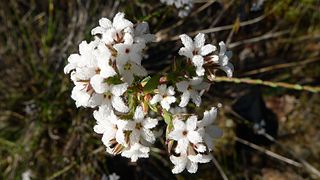
Leucopogon microphyllus is a species of flowering plant in the heath family Ericaceae and is endemic to eastern Australia. It is a bushy or spreading shrub with egg-shaped leaves, sometimes with the narrower end towards the base, and compact spikes of usually four to nine white, tube-shaped flowers.

Leucopogon obovatus is a species of flowering plant in the heath family Ericaceae and is endemic to the southwest of Western Australia. It is an erect shrub with hairy young branchlets, variably-shaped, simple leaves, and erect clusters of 3 to 15 white, bell-shaped flowers on the ends of branches and in upper leaf axils.
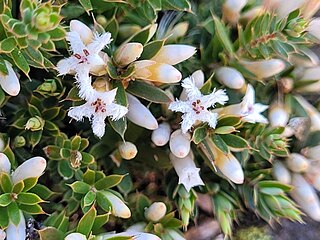
Styphelia nesophila, commonly known as sharp beard-heath, is a species of flowering plant in the heath family Ericaceae and is native to south-eastern Australia and New Zealand, where it is known as pātōtara, or dwarf mingimingi. It is a prickly, prostrate to trailing or low-growing shrub with egg-shaped leaves, and erect, tube-shaped white flowers usually arranged singly in leaf axils.

Styphelia malayana is a plant in the family Ericaceae native to Cambodia, Malaya, Myanmar, Thailand, and Vietnam. It was first formally described in 1820 as Leucopogon malayanum by William Jack in Malayan Miscellanies, who "found (it) abundantly at Singapore". In 1912, Johannes Jacobus Smith transferred the species to Styphelia as S. malayana.

Styphelia mutica, commonly known as blunt beard-heath, is a species of flowering plant in the heath family Ericaceae and is endemic to eastern Australia. It is an erect, straggling shrub with egg-shaped leaves with the narrower end towards the base, and small numbers of white, tube-shaped flowers that are densely bearded inside.

Styphelia appressa is a species of flowering plant in the heath family Ericaceae and is endemic to south-eastern New South Wales. It is a small, spreading to erect shrub with wiry stems, lance-shaped or narrowly egg-shaped to elliptic leaves and small white flowers.

Styphelia biflora is a species of flowering plant in the heath family Ericaceae and is endemic to eastern Australia. It is an erect to spreading shrub with hairy branchlets, oblong leaves and small white flowers.

Styphelia deformis is a species of flowering plant in the heath family Ericaceae and is endemic to eastern coastal Australia. It is a bushy shrub with narrowly egg-shaped leaves, and white, tube-shaped flowers.

Leucopogon gelidus is a species of flowering plant in the heath family Ericaceae and is native to south-eastern continental Australia. It is a slender, compact shrub with elliptic to egg-shaped leaves, and spikes of drooping, tube-shaped white flowers.
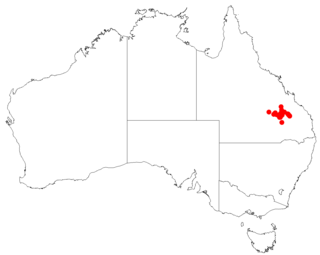
Styphelia grandiflora is a species of flowering plant in the heath family Ericaceae and is endemic to Carnarvon National Park in south-eastern Queensland. It is a shrub with softly-hairy branchlets, oblong leaves and white flowers.
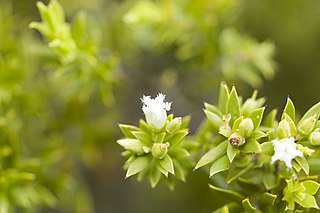
Styphelia leptospermoides is a species of flowering plant in the heath family Ericaceae and is endemic to eastern Australia. It is an erect, bushy shrub with elliptic to lance-shaped or oblong leaves, and white, tube-shaped flowers usually arranged singly in upper leaf axils.
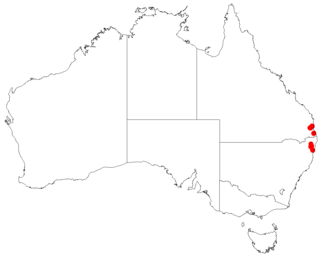
Styphelia recurvisepala is a species of flowering plant in the heath family Ericaceae and is endemic to eastern Australia. It is an erect to spreading shrub with linear leaves and erect, white, tube-shaped flowers usually arranged singly or in pairs in leaf axils.
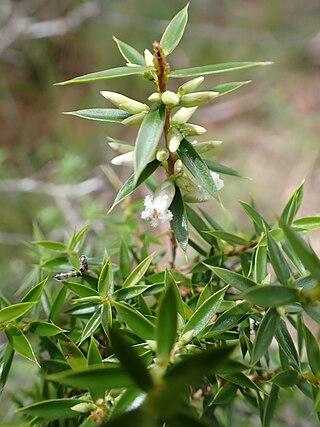
Styphelia trichostyla, commonly known as daphne heath, is a species of flowering plant in the heath family Ericaceae, and is endemic to eastern Australia. It is an erect to spreading shrub with elliptic to egg-shaped leaves, and white, tube-shaped flowers arranged singly or in groups of up to three in leaf axils.

Leucopogon virgatus, commonly known as common beard-heath, is a species of flowering plant in the heath family Ericaceae and is endemic to south-eastern Australia. It is an erect to low-lying shrub with linear to narrowly lance-shaped or egg-shaped leaves, and erect clusters of three to seven white, tube-shaped flowers on the ends of branches and in upper leaf axils.
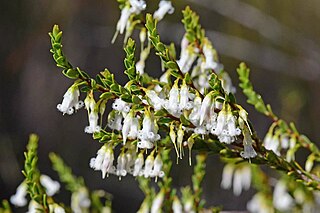
Styphelia woodsii, commonly known as nodding beard-heath, is a species of flowering plant in the heath family Ericaceae and is endemic to southern continental Australia. It is a slender shrub with more or less erect, egg-shaped leaves, and pendent white, tube-shaped flowers with densely bearded lobes.

Styphelia laeta, commonly known as five corners, is a species of flowering plant in the heath family Ericaceae and is endemic to New South Wales. It is a slender, erect shrub with broadly elliptic or egg-shaped leaves and pale yellowish-green or red flowers arranged singly in leaf axils.





















